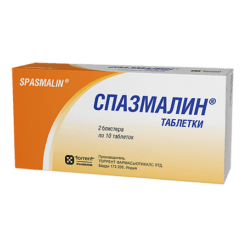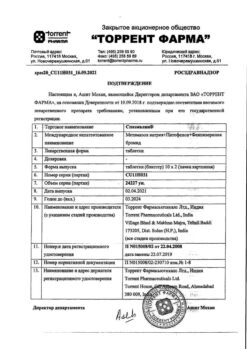No products in the cart.
Spasmalin, 5 ml 5 pcs
€1.00
Out of stock
(E-mail when Stock is available)
Description
Spasmalin® is a combination drug containing: non-narcotic analgesic sodium metamizole myotropic antispasmodic agent pitophenone and m-cholinergic agent phenpiperinia bromide.
Sodium metamizole, a derivative of pyrazolone, has analgesic antipyretic and mild anti-inflammatory effects. Pitophenone, like papaverine, has a direct myotropic effect on the smooth muscles of internal organs and causes them to relax. Phenpiperinia bromide due to its m-cholinoblocking action has an additional myotropic effect on the smooth muscles.
Pharmacokinetics:
Sodium metamizole undergoes intense biotransformation in the body only after intravenous administration a small concentration of unchanged sodium metamizole is found in plasma. Binding of active metabolite with proteins is 50 – 60%. It is mainly excreted by the kidneys. In therapeutic doses penetrates into breast milk.
Pitophenone is excreted in the urine; maximum concentration in plasma is reached within 30-60 min; elimination half-life is 18 hours.
Phenpiperinia bromide is excreted by the kidneys 324 – 404% in unchanged form with the bile 25 – 53% of the substance is excreted.
Indications
Indications
Active ingredient
Active ingredient
Composition
Composition
1 ml of the solution contains:
The active ingredients: sodium metamizole (analgin) 500 mg, pitophenone hydrochloride 2 mg and phenpiperinia bromide 0.02 mg;
Auxiliary substances: citric acid monohydrate, water for injection.
How to take, the dosage
How to take, the dosage
Parenteral administration is usually used in emergencies (renal or biliary colic) and when oral administration is not possible (or gastrointestinal absorption is impaired).
In adults, the average dose for intravenous administration is 2 ml. In/m is administered 2-5 ml of the solution 2-3 times per day; maximum daily dose is 10 ml. The duration of treatment is not more than 5 days.
In children doses of Spasmalin for intravenous or intravenous administration are set depending on age.
Interaction
Interaction
Simultaneous use of Spasmalin with other non-opioid analgesics may lead to mutually reinforcing effects.
In concomitant use tricyclic antidepressants, oral contraceptives, allopurinol impair the metabolism of sodium metamizole in the liver and increase its toxicity.
When used concomitantly, barbiturates, phenylbutazone and other inducers of microsomal liver enzymes weaken the effects of sodium metamizole.
Concomitant use of Spasmalin decreases the plasma concentration of cyclosporine.
When used concomitantly, sedatives and tranquilizers increase the analgesic effect of Spasmalin.
Concomitant use with histamine H1 receptor blockers, butyrophenones, phenothiazines, amantadine and quinidine may increase the m-cholinolytic effect of the drugs.
Concomitant use with ethanol may mutually enhance the effects.
Special Instructions
Special Instructions
It is not recommended to take ethanol during treatment with the drug. In case of long-term (more than one week) treatment it is necessary to monitor peripheral blood count and liver function status.
In case of suspected agranulocytosis or in the presence of thrombocytopenia the drug should be discontinued.
It is unacceptable to use to relieve acute abdominal pain (until the cause is determined).
Intolerance is very rare, but the risk of anaphylactic shock after IV administration is relatively higher than after oral administration.
Patients with atopic bronchial asthma and pollinosis have an increased risk of allergic reactions.
Parenteral administration should only be used when oral administration is not possible (or absorption from the gastrointestinal tract is compromised). Particular caution is required when administering more than 2 ml of the solution (risk of rapid drop in blood pressure). Intravenous injection should be carried out slowly in the “supine” position and under control of blood pressure, heart rate and respiratory rate.
In the treatment of children under 5 years of age and patients receiving cytostatic drugs, administration of sodium metamizole should be carried out only under medical supervision. For intramuscular administration a long needle must be used. Urine may be stained red due to excretion of the metabolite of sodium metamizole (of no clinical significance).
Contraindications
Contraindications
For intravenous administration – infant age (less than 1 year) or body weight less than 9 kg. For intravenous administration – infant age (up to 3 months) or body weight less than 5 kg.
Hepatic/liver failure bronchial asthma susceptibility to arterial hypotension hypersensitivity to nonsteroidal anti-inflammatory drugs Complete or incomplete combination of bronchial asthma polyposis nasal and intolerance of acetylsalicylic acid and other nonsteroidal anti-inflammatory drugs.
Side effects
Side effects
Urinary system disorders: impaired renal function oliguria anuria proteinuria interstitial nephritis red staining of urine. Cardiovascular system disorders: decreased arterial pressure.
Hematopoietic organs: thrombocytopenia leukopenia agranulocytosis (may manifest as the following symptoms: unexplained fever, chills, sore throat, difficulty swallowing stomatitis and development of vaginitis.
Anticholinergic effects: dry mouth reduced sweating paresis of accommodation tachycardia difficult urination.
Local reactions: infiltrates may occur at the injection site if administered by injection.
Overdose
Overdose
Symptoms: vomiting, decreased blood pressure, drowsiness, confusion, nausea, epigastric pain, liver and kidney function disorders, seizures.
Treatment: gastric lavage, administration of activated charcoal; symptomatic therapy if necessary.
Pregnancy use
Pregnancy use
Similarities
Similarities
Additional information
| Shelf life | 3 years. |
|---|---|
| Conditions of storage | At a temperature below 30°C in a light-protected place. Store out of the reach of children. |
| Manufacturer | Torrent Pharmaceuticals Ltd, India |
| Medication form | solution |
| Brand | Torrent Pharmaceuticals Ltd |
Other forms…
Related products
Buy Spasmalin, 5 ml 5 pcs with delivery to USA, UK, Europe and over 120 other countries.

















